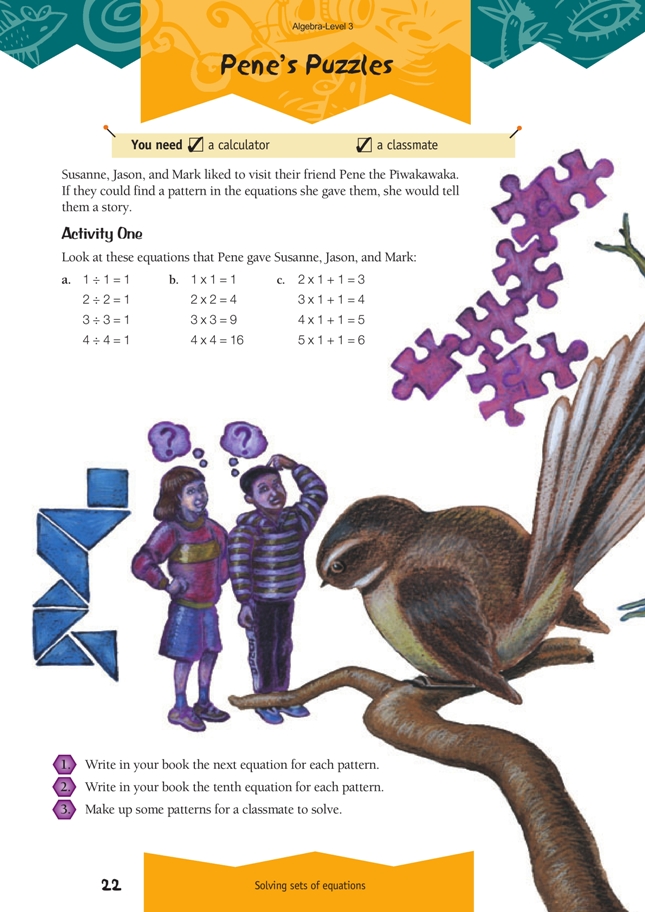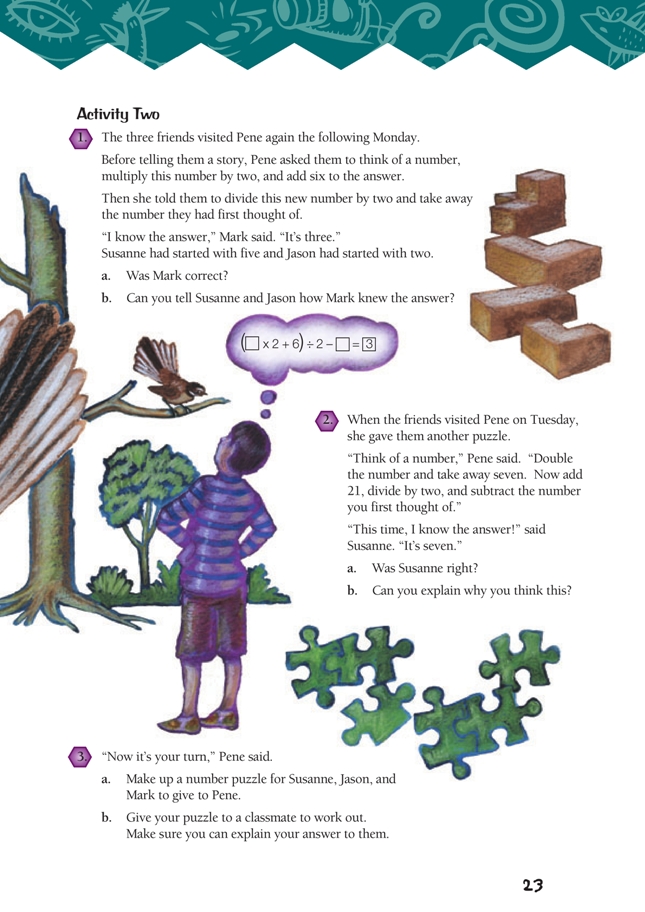This is a level 3 algebra strand activity from the Figure It Out series.
A PDF of the student activity is included.
Click on the image to enlarge it. Click again to close. Download PDF (477 KB)
solve sets of equations
FIO, Level 3, Algebra, Pene's Puzzles, pages 22-23
classmate
Activity One
The sequence in these patterns leads towards students developing rules. Students may wish to complete the pattern through to the tenth element in order to answer question 2, but do encourage them to also use more efficient methods. See Answers and Teachers’ Notes: Algebra, Figure It Out, Levels 2–3, page 25.
Activity Two
If students aren’t convinced that Mark’s answer for question 1 is always three, have them try the puzzle several times with different numbers. You may like to work through the puzzle with students to help them identify what is happening. Using the notation in Mark’s speech bubble is especially useful because it makes students more familiar with algebraic notation, and writing the puzzle down is much easier than doing it mentally, as Mark has done.
In order to always get an answer of three, the steps in the equation must, to a certain extent, cancel each other out. So students need to look for inverse operations that do cancel each other out:
The operations x 2 and ÷ 2 cancel each other out. Six has been added on, but this is also divided by two so is now three. The original number is cancelled out by subtraction, leaving an answer of three.
Remind students to keep these points in mind when they make up their own puzzles. Most of the operations that they include in their puzzles will have to cancel each other out.
You may find the following algebraic proofs interesting (although students will not yet be using this level of algebra).
1.
Let n be the number thought of.
Take away the first number thought of: n + 3 – n = 3.
2.
Let n be the number thought of.
Double it: 2n.
Take away 7: 2n – 7.
Add 21: 2n – 7 + 21 = 2n + 14.
Divide by 2: n + 7.
Subtract n: n + 7 – n = 7
Answers to Activities
Activity One
1. a. 5 ÷ 5 = 1
b. 5 x 5 = 25
c. 6 x 1 + 1 = 7
2. a. 10 ÷ 10 = 1
b. 10 x 10 = 100
c. 11 x 1 + 1 = 12
3. Answers will vary.
Activity Two
1. a. Yes
b. One explanation is: Mark knew that x 2 and ÷ 2 cancelled each other out, 6 ÷ 2 = 3, and = 0. The only number left is 3, which
is the answer.
2. a. Yes
b. This can be explained in 2 steps.
Step 1: The puzzle can be written as
( x 2 – 7 + 21) ÷ 2 = ![]()
This can be simplified to ( x 2 + 14) ÷ 2 = ![]()
and then to + 7 = ![]()
Step 2: ![]() – = 7. (
– = 7. ( ![]() will always be your number plus 7. When you subtract your number, you will always be left with 7 as an answer.)
will always be your number plus 7. When you subtract your number, you will always be left with 7 as an answer.)
3. Puzzles and solutions will vary.


